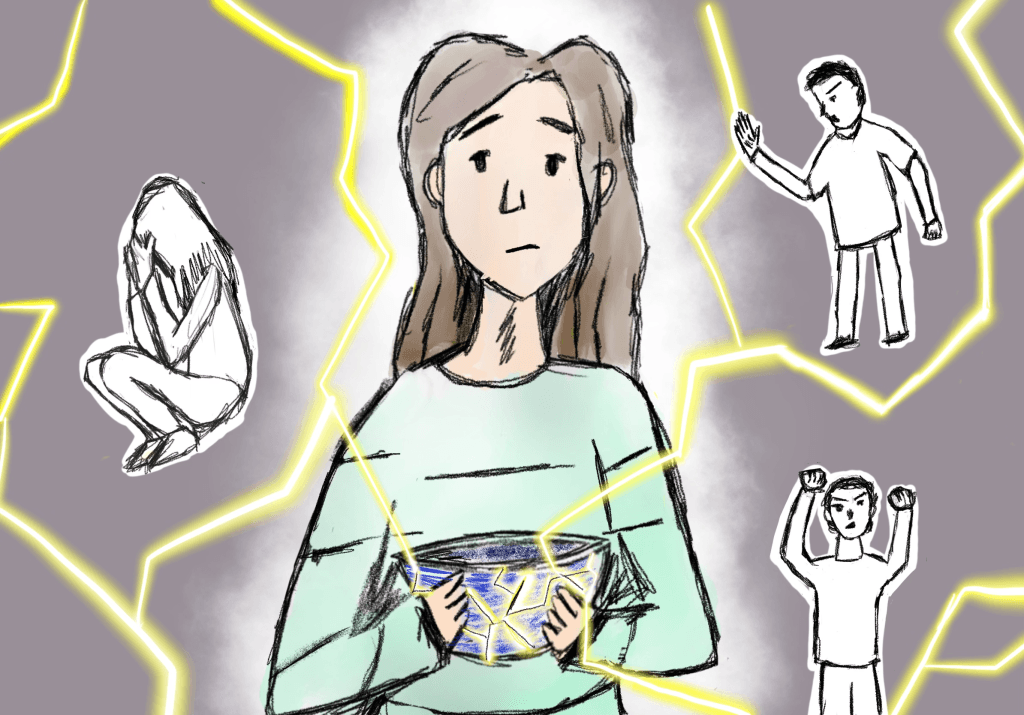Art by Jackie Lopez
Transparency Item: The Perspectives section of the Graphic is comprised of articles based on opinion. This is the opinion and perspective of the writer.
“Good damage” is a term coined from season 6, episode 10 in popular Netflix show “BoJack Horseman.” Writer Diane Nguyen’s depression has eased, but she still struggles to start writing her memoir, according to IMDb.
As Diane reflects through her past, she finds difficulty verbalizing all the pain she experienced. Within the scramble of Diane’s thought process, utilizing the art of kintsugi as a metaphor for people’s stories pops into mind.
Kintsugi is the Japanese art of repairing broken pottery with lacquer mixed with powdered gold, silver or platinum, according to Traditional Kyoto. Rather than covering its flaws, the breakage and repair become something beautiful and are displayed as part of the object’s history.
But the idea is quickly overwhelmed by her frantic, pressing thoughts that shout, “Is that something? Is any of this anything?”
These are fair questions. Anyone who has been hurt in some way has wrestled with resolve, repeatedly recalling and scrutinizing the event in hope of finding some explanation for why it happened.
Ironically, it is Diane’s trauma that causes her to experience difficulty expressing herself. Her family frequently belittled her growing up, and her ex-husband rarely listened when she voiced her needs and concerns.
Such people learn it is unsafe to show genuine emotions and share true thoughts, so their feelings become repressed, according to PsychCentral.
Sometimes people may feel like they have to emerge from traumatizing experiences with some inspiring message or greater version of themselves, such as saying they were glad they went through it because they came out stronger than before, or they were grateful because it was part of God’s plan.
Obviously, it is not terrible for people to find their peace and recover, but these messages alone can romanticize and even downplay the consequences of such events. Victims may feel frustration when they cannot reach a perfect moral-of-the-story ending.
Diane faces similar frustrations writing her memoir as she struggles to extract an articulate message from her painful past.
“Because if I don’t [write the memoir], that means the damage I got isn’t good damage — it’s just damage,” Diane said. “I have gotten nothing out of it, and all those years I was miserable was for nothing.”
Despite there being no simple explanation for why terrible things happen, I would like to believe unexplained suffering is not all for nothing.
“When I was a little girl, I thought that everything — all the abuse and neglect — somehow made me special,” Diane said.
However, Diane realized the truth of the matter is that damage is simply that —damage. Nothing more, nothing less. There is nothing empowering or fantastical about it. It doesn’t give anyone more or less value than the next person, and we don’t always find a reason for why it happened.
When trauma is not treated for what it is, people misunderstand their hurts through a warped lens that becomes a hindrance to their recovery and progress.
At one point, while trying to write her memoir at a mall, Diane winds up writing a few pages of a young adult mystery titled “Ivy Tran, Food Court Detective.”
Diane tries to reject this idea despite receiving positive feedback. She rants to her friend that she wanted to write something profound, something that would make little girls like her feel less alone, not some teenage detective story.
Her friend gently responds that maybe Diane could still write this young adult book, and maybe it could speak truths to that same audience too.
“Ivy Tran, Food Court Detective” is not what Diane wants now, but what she needs. She can always write her memoir at a later time, but in the moment, deep down, she enjoys writing the young adult book. In later episodes, it proves to be another way of expressing herself.
Perhaps all people can really do is lean into the present, taking it one day at a time and doing what they need for themselves. People may never discover nor fully understand the reasons for difficult experiences. So what’s the rush? Why pile on the pressure to make it inspiring if you are still trying to process things?
The cracks of the past become part of a person’s history and contribute in some way to their personal development. Trauma itself is not beautiful; it is a terrible thing, but that does not mean the people themselves are.
It is OK to take things at one’s own pace, and the fact that people try to keep on going is what makes them beautiful.
Damage doesn’t have to be good damage. Sometimes, damage is just damage, and we can learn to accept that is all it really is.
_________________
Follow the Graphic on Twitter: @PeppGraphic
Email Faith Oh: faith.oh@pepperdine.edu


